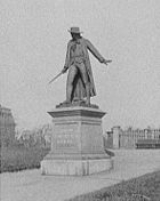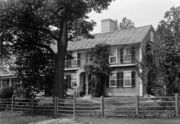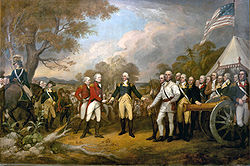
William Prescott
Encyclopedia



American Revolutionary War
The American Revolutionary War , the American War of Independence, or simply the Revolutionary War, began as a war between the Kingdom of Great Britain and thirteen British colonies in North America, and ended in a global war between several European great powers.The war was the result of the...
who commanded the rebel forces in the Battle of Bunker Hill
Battle of Bunker Hill
The Battle of Bunker Hill took place on June 17, 1775, mostly on and around Breed's Hill, during the Siege of Boston early in the American Revolutionary War...
. Prescott is known for his order to his soldiers, "Do not fire until you see the whites of their eyes", such that the rebel troops may shoot at the enemy at shorter ranges, and therefore more accurately and lethally, and so conserve their limited stocks of ammunition. It is debated whether Prescott or someone earlier coined this memorable saying.
Life
Prescott was born in Groton, MassachusettsGroton, Massachusetts
Groton is a town located in northwestern Middlesex County, Massachusetts. The population was 10,646 at the 2010 census. It is home to two noted prep schools: Groton School, founded in 1884, and Lawrence Academy at Groton, founded in 1793. The historic town hosts the National Shepley Hill Horse...
to Benjamin Prescott (1696–1738) and Abigail Oliver Prescott (1697–1765). He married Abigail Hale (1733–1821) on April 13, 1758, and they had one son, also named William, in 1762. Prescott owned a house in Pepperell, Massachusetts
Pepperell, Massachusetts
Pepperell is a town in Middlesex County, Massachusetts, United States. The population was 11,497 at the 2010 census. It includes the village of East Pepperell.-History:...
, on Prescott Street.
Prescott served in the provincial militia in King George's War
King George's War
King George's War is the name given to the operations in North America that formed part of the War of the Austrian Succession . It was the third of the four French and Indian Wars. It took place primarily in the British provinces of New York, Massachusetts Bay, New Hampshire, and Nova Scotia...
where he served in the 1745 Siege of Louisbourg
Siege of Louisbourg (1745)
The Siege of Louisbourg took place in 1745 when a New England colonial force aided by a British fleet captured Louisbourg, the capital of the French province of Île-Royale during the War of the Austrian Succession, known as King George's War in the British colonies.Although the Fortress of...
under William Pepperrell
William Pepperrell
Sir William Pepperrell, 1st Baronet was a merchant and soldier in Colonial Massachusetts. He is widely remembered for organizing, financing, and leading the 1745 expedition that captured the French garrison at Fortress Louisbourg during King George's War...
. He may have played a role in the naming of the town of Pepperell, Massachusetts
Pepperell, Massachusetts
Pepperell is a town in Middlesex County, Massachusetts, United States. The population was 11,497 at the 2010 census. It includes the village of East Pepperell.-History:...
, after his commander when it was separated from Groton in 1753. In 1755, when the French and Indian War
French and Indian War
The French and Indian War is the common American name for the war between Great Britain and France in North America from 1754 to 1763. In 1756, the war erupted into the world-wide conflict known as the Seven Years' War and thus came to be regarded as the North American theater of that war...
widened, he saw action at the Battle of Fort Beausejour
Battle of Fort Beauséjour
The Battle of Fort Beauséjour was fought on the Isthmus of Chignecto and marked the end of Father Le Loutre’s War andthe opening of a British offensive in the French and Indian War, which would eventually lead to the end the French Empire in North America...
. He turned down an offer to join the Royal Army for his service in that war.
American Revolutionary War
In 1774, when Massachusetts towns began forming militia companies, Prescott was made a colonel commanding the Pepperell company. The alarm that was raised on the evening of April 18, 1775, that British troops were marching on ConcordConcord, Massachusetts
Concord is a town in Middlesex County, Massachusetts, in the United States. As of the 2010 census, the town population was 17,668. Although a small town, Concord is noted for its leading roles in American history and literature.-History:...
reached Pepperell about 10 a.m. on April 19. Prescott immediately alerted the companies of Pepperell, Hollis
Hollis, New Hampshire
Hollis is a town in Hillsborough County, New Hampshire, United States. The population was 7,684 at the 2010 census. The town center village is listed on the National Register of Historic Places as Hollis Village Historic District....
, and Groton, and rode toward Concord. The companies arrived too late to participate in the day's battles
Battles of Lexington and Concord
The Battles of Lexington and Concord were the first military engagements of the American Revolutionary War. They were fought on April 19, 1775, in Middlesex County, Province of Massachusetts Bay, within the towns of Lexington, Concord, Lincoln, Menotomy , and Cambridge, near Boston...
, but they became part of the small army that laid siege to Boston afterward
Siege of Boston
The Siege of Boston was the opening phase of the American Revolutionary War, in which New England militiamen—who later became part of the Continental Army—surrounded the town of Boston, Massachusetts, to prevent movement by the British Army garrisoned within...
.
When the American military commanders were alerted to British plans to capture undefended high ground at Dorchester Heights
Dorchester Heights
Dorchester Heights is the central area of South Boston. It is the highest area in the neighborhood and commands a view of both Boston Harbor and downtown.-History:...
and Charlestown
Charlestown, Massachusetts
Charlestown is a neighborhood of Boston, Massachusetts, United States, and is located on a peninsula north of downtown Boston. Charlestown was originally a separate town and the first capital of the Massachusetts Bay Colony; it became a city in 1847 and was annexed by Boston on January 5, 1874...
, Prescott was chosen to lead 1,200 men onto the Charlestown peninsula and erect defenses on Bunker Hill
Battle of Bunker Hill
The Battle of Bunker Hill took place on June 17, 1775, mostly on and around Breed's Hill, during the Siege of Boston early in the American Revolutionary War...
on the night of June 16, 1775. The actual defenses were built on Breeds Hill, as it was lower and closer to the harbor. The next day, his troops, who were tired from working to construct a redoubt
Redoubt
A redoubt is a fort or fort system usually consisting of an enclosed defensive emplacement outside a larger fort, usually relying on earthworks, though others are constructed of stone or brick. It is meant to protect soldiers outside the main defensive line and can be a permanent structure or a...
and other defensive works, and had only limited ammunition, formed the centerpiece of the American defenses when the British attacked the position
Battle of Bunker Hill
The Battle of Bunker Hill took place on June 17, 1775, mostly on and around Breed's Hill, during the Siege of Boston early in the American Revolutionary War...
. The British began firing from the ship Lively at 4 a.m. attacked at 3 p.m. In spirited battle, Prescott's men twice threw back British assaults on the redoubt. When the British made a third attempt, his men were almost out of ammunition; after an initial volley, he ordered a retreat from the redoubt. He was one of the last men to leave the redoubt, parrying bayonet
Bayonet
A bayonet is a knife, dagger, sword, or spike-shaped weapon designed to fit in, on, over or underneath the muzzle of a rifle, musket or similar weapon, effectively turning the gun into a spear...
thrusts with his ceremonial saber. While the British successfully captured Bunker Hill, the poorly-organized colonial forces inflicted significant casualties, and the British were unable to capitalize on their victory. They lost 50 percent of the force commanded by General Howe
William Howe, 5th Viscount Howe
William Howe, 5th Viscount Howe, KB, PC was a British army officer who rose to become Commander-in-Chief of British forces during the American War of Independence...
, that were killed or wounded. Prescott is widely seen as having played a key role in the battle, keeping the relatively poorly-trained militia under his command well-disciplined.
When the Second Continental Congress
Second Continental Congress
The Second Continental Congress was a convention of delegates from the Thirteen Colonies that started meeting on May 10, 1775, in Philadelphia, Pennsylvania, soon after warfare in the American Revolutionary War had begun. It succeeded the First Continental Congress, which met briefly during 1774,...
established the Continental Army
Continental Army
The Continental Army was formed after the outbreak of the American Revolutionary War by the colonies that became the United States of America. Established by a resolution of the Continental Congress on June 14, 1775, it was created to coordinate the military efforts of the Thirteen Colonies in...
it sent George Washington
George Washington
George Washington was the dominant military and political leader of the new United States of America from 1775 to 1799. He led the American victory over Great Britain in the American Revolutionary War as commander-in-chief of the Continental Army from 1775 to 1783, and presided over the writing of...
to take command of the forces besieging Boston. Prescott received a colonel's commission, and his unit became the 7th Continental Regiment
7th Continental Regiment
The 7th Continental Regiment was raised April 23, 1775 as a Massachusetts militia Regiment at Cambridge, Massachusetts under Colonel William Prescott. The regiment would join the Continental Army in June 1775. The regiment saw action during the Siege of Boston and the New York Campaign...
. The regiment saw service in the 1776 defense of New York
New York and New Jersey campaign
The New York and New Jersey campaign was a series of battles for control of New York City and the state of New Jersey in the American Revolutionary War between British forces under General Sir William Howe and the Continental Army under General George Washington in 1776 and the winter months of 1777...
. While he appears to have given up command of the regiment after that campaign, he apparently participated in some capacity in the 1777 Saratoga campaign
Saratoga campaign
The Saratoga Campaign was an attempt by Great Britain to gain military control of the strategically important Hudson River valley in 1777 during the American Revolutionary War...
, for he is depicted in the painting of the Surrender of General Burgoyne
John Burgoyne
General John Burgoyne was a British army officer, politician and dramatist. He first saw action during the Seven Years' War when he participated in several battles, mostly notably during the Portugal Campaign of 1762....
at Saratoga
Saratoga, New York
Saratoga is a town in Saratoga County, New York, United States. The population was 5,141 at the 2000 census. It is also the commonly used, but not official, name for the neighboring and much more populous city, Saratoga Springs. The major village in the town of Saratoga is Schuylerville which is...
by John Trumbull
John Trumbull
John Trumbull was an American artist during the period of the American Revolutionary War and was notable for his historical paintings...
,
which hangs in the U.S. Capitol Rotunda. His departure from military service may be due to injuries sustained in an accident on his farm.
Later life
Prescott served in the Massachusetts General CourtMassachusetts General Court
The Massachusetts General Court is the state legislature of the Commonwealth of Massachusetts. The name "General Court" is a hold-over from the Colonial Era, when this body also sat in judgment of judicial appeals cases...
in later years, and served in militia called out to suppress the Shays' Rebellion
Shays' Rebellion
Shays' Rebellion was an armed uprising in central and western Massachusetts from 1786 to 1787. The rebellion is named after Daniel Shays, a veteran of the American Revolutionary War....
in 1786. He died in 1795.
Legacy
His grandson William H. PrescottWilliam H. Prescott
William Hickling Prescott was an American historian and Hispanist, who is widely recognized by historiographers to have been the first American scientific historian...
was a noted historian and author, who married the granddaughter of Captain John Linzee, captain of the HMS Falcon, one of the British ships that fired on Bunker Hill.
The former town of Prescott, Massachusetts
Prescott, Massachusetts
Prescott is a former town in Hampshire County, Massachusetts. It was incorporated in 1822 from portions of Pelham and New Salem. It was named in honor of Colonel William Prescott, who commanded the American forces at the Battle of Bunker Hill. It was disincorporated on April 28, 1938 as part of...
, was named in his honor. The town was disincorporated in 1938 as part of the building of the Quabbin Reservoir
Quabbin Reservoir
The Quabbin Reservoir is the largest inland body of water in the Commonwealth of Massachusetts and was built between 1930 and 1939. Today along with the Wachusett Reservoir, it is the primary water supply for Boston, some to the east, as well as 40 other communities in Greater Boston...
, and the land now makes up Prescott Peninsula, which divides the main branches of the reservoir.
Prescott's likeness was made into a statue for a memorial for the Battle of Bunker Hill.
Prescott's house is located in North Pepperell, Massachusetts.
Prescott appears as a character in Thomas Wm. Hamilton's science fiction
Science fiction
Science fiction is a genre of fiction dealing with imaginary but more or less plausible content such as future settings, futuristic science and technology, space travel, aliens, and paranormal abilities...
novel Time for Patriots, ISBN 978-1-60693-224-7.

